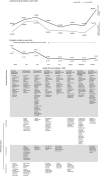The impact of government pandemic policies on the vulnerability of healthcare workers to SARS-CoV-2 infection and mortality in Jakarta Province, Indonesia
- PMID: 38206905
- PMCID: PMC10786428
- DOI: 10.1080/07853890.2023.2293306
The impact of government pandemic policies on the vulnerability of healthcare workers to SARS-CoV-2 infection and mortality in Jakarta Province, Indonesia
Erratum in
-
Correction.Ann Med. 2023;55(2):2317590. doi: 10.1080/07853890.2024.2317590. Epub 2024 Feb 16. Ann Med. 2023. PMID: 38364222 Free PMC article. No abstract available.
Abstract
Introduction: Healthcare workers (HCWs) are on the frontlines of the COVID-19 pandemic, putting them at a higher risk of infection and disease than non-HCWs. We analysed the effects of government policies for the public and for HCWs on the likelihood of Severe Acute Respiratory Syndrome Coronavirus 2 (SARS-CoV-2) infection and mortality among HCWs during the first 8 months of the pandemic in Jakarta province, the capital city and COVID-19 hotspot in Indonesia.
Methods: We conducted a retrospective cohort study using secondary data from the Jakarta provincial government from March to October 2020, which included sociodemographic characteristics, symptoms, comorbidities and COVID-19 diagnosis history for all cases. A generalized linear mixed-effect regression model was used to determine the effect of each month on the odds ratio (OR) of COVID-19 cases and deaths for HCW compared with non-HCW, assuming that monthly trends were influenced by varying government policies.
Results: A total of 894,487 suspected and confirmed COVID-19 cases in health facilities in Jakarta province were analysed. The OR of confirmed cases for HCW was 2.04 (95% CI 2.00-2.08; p < .001) compared to non-HCW. Despite this higher OR for infection, the case fatality rate (2.32 per 100) and OR (1.02, 95% CI 0.93-1.11; p = .65) of COVID-19 deaths for HCW were similar to those of non-HCW. We observed a trend towards a lower number of COVID-19 patients in hospitals and lower odds of COVID-19 cases among HCWs during the April-to-July 2020 phase compared to the August-to-October phase. This chronologically aligned with more extensive policies to support hospital-based, community-based and well-being-related actions to protect HCW.
Conclusions: HCW had higher odds of having SARS-CoV-2 infection, yet similar odds of death from COVID-19, as compared to non-HCW. Government policies with collective efforts to prevent hospital overcapacity during high transmission and burden periods of the pandemic should be prioritized.
Keywords: COVID-19; Indonesia; SARS-CoV-2; healthcare worker; policy.
Plain language summary
Healthcare workers (HCWs) had higher exposure and odds of Severe Acute Respiratory Syndrome Coronavirus 2 (SARS-CoV-2) infection than non-HCWs but a similar risk of death, consistent with previous studies.Government policies favouring reduced workloads of HCW and interventions to promote resilience can be achieved through combined hospital-based, community-based and well-being-related approaches.Studies to identify the patterns and trends of COVID-19 cases and deaths, hospital admissions and policy dynamics are important to promote evidence-based decision-making by the government.
Conflict of interest statement
No potential conflict of interest was reported by the author(s).
Figures


Similar articles
-
COVID-19 prevalence among healthcare workers in Jakarta and neighbouring areas in Indonesia during early 2020 pandemic.Ann Med. 2021 Dec;53(1):1896-1904. doi: 10.1080/07853890.2021.1975309. Ann Med. 2021. PMID: 34783269 Free PMC article.
-
Epidemiology, clinical characteristics, household transmission, and lethality of severe acute respiratory syndrome coronavirus-2 infection among healthcare workers in Ontario, Canada.PLoS One. 2020 Dec 28;15(12):e0244477. doi: 10.1371/journal.pone.0244477. eCollection 2020. PLoS One. 2020. PMID: 33370384 Free PMC article.
-
Impact of social contacts on SARS-CoV-2 exposure among healthcare workers.Occup Med (Lond). 2022 Jan 13;72(1):10-16. doi: 10.1093/occmed/kqab141. Occup Med (Lond). 2022. PMID: 34633044 Free PMC article.
-
The need of health policy perspective to protect Healthcare Workers during COVID-19 pandemic. A GRADE rapid review on the N95 respirators effectiveness.PLoS One. 2020 Jun 3;15(6):e0234025. doi: 10.1371/journal.pone.0234025. eCollection 2020. PLoS One. 2020. PMID: 32492045 Free PMC article.
-
The role of routine SARS-CoV-2 screening of healthcare-workers in acute care hospitals in 2020: a systematic review and meta-analysis.BMC Infect Dis. 2022 Jul 2;22(1):587. doi: 10.1186/s12879-022-07554-5. BMC Infect Dis. 2022. PMID: 35780088 Free PMC article.
References
-
- WHO . WHO Coronavirus Disease (COVID-19) dashboard; 2021. [cited 2021 Nov 9]. Available from: https://covid19.who.int/
-
- Prajogo D, Sohal A, Dewi RS, et al. Occupational Health and Safety (OHS): protecting the Indonesian Healthcare Workforce during the COVID-19 pandemic; 2022. [cited 2022 Dec 16]. Available from: https://pair.australiaindonesiacentre.org/wp-content/uploads/2021/12/Occ...
-
- Kompas . Kematian tenaga medis Indonesia akibat Covid-19 tertinggi di Asia, Kenapa? 2021. [cited 2021 Nov 10]. Available from: https://www.kompas.com/sains/read/2021/01/28/141625123/terbanyak-di-asia...
Publication types
MeSH terms
LinkOut - more resources
Full Text Sources
Medical
Miscellaneous
